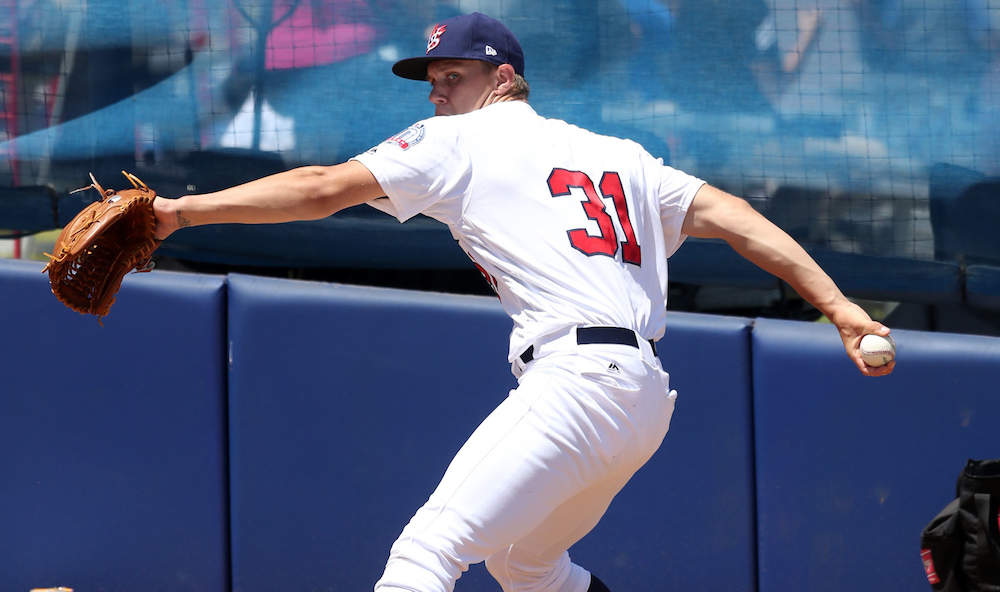Feature Photo: Tanner Houck, RHP, Red Sox
(with USA Baseball Collegiate National Team in 2016)
Ted Lekas, Mark Shreve, and Spencer Hansen offer up looks from the NY-Penn, Eastern, and Pacific Coast Leagues, respectively, this week. Lekas viewed 2015 first-rounder Matt Manning’s (RHP, Tigers) last start before being bumped to Class A West Michigan, as well as the Red Sox’ 2015 first-rounder and righty Tanner Houck. Shreve profiles lefty Brandon Waddell from the Pirates, a fifth-round selection in the 2015 MLB Draft who is struggling to find the control he had in leading the Virginia Cavaliers to the College World Series in 2015 as he works through arm trouble this year at Double-A Altoona. He also spotlights righty Brody Koerner’s last start at Trenton. And Hansen spent last weekend up in Tacoma, getting looks at outfielder Ian Miller and right-handed reliever Max Povse for the Rainiers.
2080 Prospect Spotlights
Short-Season A
 Matt Manning, RHP, Tigers (Short-Season A Connecticut, New York-Penn League)
Matt Manning, RHP, Tigers (Short-Season A Connecticut, New York-Penn League)
Ht/Wt: 6’6”/190 lbs. B/T: R/R Age (As of April 1, 2017): 19y, 3m
Manning, the Tigers’ first rounder last year (#9 overall) out of Sheldon H.S. (Sacramento, CA), was bumped to Class A West Michigan a few days after my view in Connecticut on August 1, where he threw five innings and allowed an unearned run and four hits, while walking two and striking out seven. For the season, he has posted a 1.89 ERA over 33 innings, with 36 strikeouts while holding hitters to a .233 batting average against. Though his 14 walks are presently a well-below-average control number, both the command and control profile should improve as he massages the mechanics, logs more innings and moves up the ladder.
Manning has a tall and lanky, well-proportioned frame, and he has the athleticism to coordinate his delivery well for his size. He works without a wind-up and has a long arm action with some stab in the back, and shows quick arm speed through a 3/4’s slot. He’ll need to work on staying closed and finishing his delivery online for more consistency, and stay over the rubber to be most effective.
Manning’s fastball is a projectable plus pitch right now, sitting at 94 mph consistently, and working from 92-to-96 mph with run and bore to both side of the plate, and he is able to vary it with some hard sinking action down in the zone. He showed average command of the pitch in this view, but the command should reach plus at maturity. The pitch should reach double-plus velocity, and the plus movement and deception will generate swings and misses. The curveball is presently an inconsistent offering, but he shows solid two-plane depth and power with the pitch in the 80-to-82 mph range, and it also projects as a plus offering. The changeup also projects as plus, sitting in the 81-to-86 mph range, though it’s most effective in the lower end of the velo range where he shows good feel and fading action, and he’ll throw it to left-handed hitters. He should develop at least average command of both of the secondaries as he builds innings.
With the three-pitch mix projecting as plus or better across the board, Manning has a ceiling of a Role 65, number three starter in the big leagues with occasional glimpse of a number two not out of the question. He reminded me of Rick Porcello (RHP, Red Sox) – Ted Lekas
 Tanner Houck, RHP, Red Sox (Short-Season A Lowell, New York-Penn League)
Tanner Houck, RHP, Red Sox (Short-Season A Lowell, New York-Penn League)
Ht/Wt: 6’5”/220 lbs. B/T: R/R Age (As of April 1, 2017): 20y, 9m
Boston’s first-rounder from this year (#24 overall) out of Missouri, Houck was a durable Friday-night starter for the Tigers, throwing 300 2/3 innings over his three seasons with a 3.27 ERA 292 strikeouts against just 63 walks (1.9 BB/9) in the tough Southeastern Conference. He’s jumped into pro ball with Lowell, and has been working on a pitch count that has limited him to 10 1/3 innings across five starts this summer, and in my view August 1, he went three innings and did not allow a hit or walk a batter, and struck out four.
Houck has the prototypical starter’s physical makeup, with a durable frame, strength throughout, and wide shoulders. He works from a no wind-up delivery with some funk to it, with a quick arm and a wrap, and with some directional issues that will need to be polished up for a smoother, online delivery that can repeat more effectively. He throws a two-and four-seam fastball with average command, sitting mostly at 94 mph with the heavy-sinking four-seamer, and with the two-seamer showing run to the arm side that was effective versus left-handed hitters. Both the velo and movement project as plus. The slider still needs some refinement, but it projects as a future above-average offering in the 81-84 mph range with tight spin and occasional tilt and depth when he doesn’t pull across late. He also shows feel for a changeup that could reach plus, sitting in the 83-to-87 mph range with fade to both sides of the plate when he doesn’t overthrow it.
Houck’s command profile and development of his secondary offerings will determine his ultimate role, as will his ability to develop more effective sequencing and feel for his arsenal. But while there is work to be done, he still has a ceiling of a Role 60, number three starter if it comes together, with a floor of a Role 50, average number four-or-five starter or set-up man. – Ted Lekas
Double-A
 Brody Koerner, RHP, Yankees (Double-A Trenton, Eastern League)
Brody Koerner, RHP, Yankees (Double-A Trenton, Eastern League)
Ht/Wt: 6’2”/220 lbs. B/T: R/R Age (As of April 1, 2017): 23y, 5m
A 17th-round draft pick out of Clemson in 2015, Koerner has worked his way up the Yankees’ system fairly quickly, and he was recently promoted to Trenton on July 3, and I was able to see his start on August 6, where he worked 5 1/3 innings in a extra-inning loss to the Altoona Curve, giving up six hits, walking one, and striking out two.
Koerner brings sound mechanics and a free and easy arm action, and average arm speed from a 3/4’s arm slot. He repeats well, and it shows in his overall plus control numbers of 1.3 and 2.3 BB/9 over his past two seasons. While he has a four-pitch mix, Koerner lives in the lower third of the zone throwing mostly sinkers sitting 88-to-91 mph with fringy dive and below-average command in the zone, and the fringe average life he gets leaves him with a 45-grade heater overall. He’ll also throw the occasional two-seamer in the 91-to-93 mph range, and a changeup in the 78-to-80 mph range that was also used sparingly. He showed some feel for spin on his breaking pitches, and he used a few for first-pitch strikes the second time through the lineup. He has feel to change shapes, ranging the looks from an 11-to-5 shaped fringy curveball that had gradual break in the 75-to-78 mph range, to an average slider with ¾’s depth and limited bite in the 82-to-85 mph range.
Despite plus control, Koerner’s command of his arsenal is below average overall, and he lacks a true out pitch at present. He’s susceptible to contact when working from behind (all six of his hits allowed in this outing were from even or behind in the count) and needs a strike. While the control numbers have been consistently plus or better in his pro career, he is working with razor thin margins in the zone, and has to work from ahead to be effective. His contact rate has risen to 10.8 H/9 over his 41 2/3 Double-A innings versus 7.9 H/9 over 36 2/3 innings in Tampa, while his GO:AO ratio has been cut in half from 2.40 in Tampa to 1.13 at Trenton, and his strikeout rate has dropped from an average 7.7 SO/9 last year to a below average 5.7 SO/9 this season. He is likely high-risk, Role 35 up-down emergency arm capable a middle relief or spot-start role if the sinker and slider command can reach average. – Mark Shreve
 Brandon Waddell, LHP, Pirates (Double-A Altoona, Eastern League)
Brandon Waddell, LHP, Pirates (Double-A Altoona, Eastern League)
Ht/Wt: 6’3”/180 lbs. B/T: L/L Age (As of April 1, 2017): 22y, 9m
Waddell, the Pirates’ 2015 fifth-rounder out of Virginia, was working 91-to-94 mph with his fastball earlier in the season before going on DL with a strain in his left forearm on June 6, his second such stint this season. He is still working to build back some arm strength after being shelved, and my viewing on August 5 was his second start with Altoona after to rehab starts, and he threw 4 2/3 innings and gave up six hits, walked three, and struck out five in a 2-1 win over Trenton.
Waddell works from an abbreviated wind-up with a medium leg lift, and it’s a fluid delivery from a 3/4’s slot with a medium arm circle and a slight hook in the back. The arm speed is average, though the arm dragged at times in this view, causing his misses to be mostly up and to the arm side. The fastball velo was down, topping out at 93 mph but with most readings 90-to-91 mph. The four-seamer gets some fringy cut and heft, and the two-seamer showed some tail and sink in the lower velo band.
His overall control profile shows that he is still struggling to consistently find the strike zone, with well-below-average BB/9 rates as a pro (4.7 BB/9 at Altoona in 2016, 4.0 this year). While some of the control issues may iron out as he regains his arm strength, the fastball command/control profile will specifically need to improve for him to get to his secondaries and have more success turning over lineups at the upper levels. He’s been doing a great job of generating ground ball contact (1.99 GO:AO over 118 innings last year, and 2.13 through his 37 1/3 innings in 2017), and he did show average command of his breaking pitches, with average slider being his most effective offering especially versus righties. It’s a future 55-grade pitch, generating soft contact and swing and miss at 83-to-86 mph. His curveball was also average, showing tight spin and 1-to-7 shape at 77-to-80 mph, and dropping it in for first-pitch strikes several times. He used the changeup (78-to-79 mph) sparingly, instead relying on the two-seamer to move away from righties. While the arm speed can sell it, the tumble was limited, and the pitch still needs some refinement to be effective.
With nothing overwhelming in the overall profile, Waddell’s ceiling may be limited to a Role 50 back-end rotation piece if he can stay healthy, and the control profile will have get to at least fringe average to reach that ceiling. If not, there could still be a fallback role coming out of the bullpen in middle relief, where the fastball velocity seen earlier in the year, and the projectable slider could play up in shorter stints. – Mark Shreve
Ed. Note: Waddell was placed on the 7-day DL for the third time this year following his last start on August 10.
Triple-A
 Ian Miller, OF, Mariners (Triple-A Tacoma, Pacific Coast League)
Ian Miller, OF, Mariners (Triple-A Tacoma, Pacific Coast League)
Ht/Wt: 6’0”/175 lbs. B/T: L/R Age (As of April 1, 2017): 25y, 1m
Miller has flown under the radar for much of his professional career after being selected in the 14th round of the MLB Draft draft in 2013 by the Mariners. Through 100 games in 2017, Miller is slashing .329/.382/.426 split between Double-A Arkansas and Triple-A Tacoma, and he could become a useful contributor to a team as a Role 40, fourth outfielder.
Miller has good hand-eye coordination and average bat speed with an inside-out, level stroke and a willingness to use the whole field. Miller’s front side opens early at times, which would cause some issues against good off-speed pitches at the big league level. He isn’t a top of the order threat because his aggressive approach lends itself to some swing-and-miss numbers and low walk rates as well (6%) in 2017).
Miller’s carry tool is his double-plus speed that plays even better underway. Miller is an aggressive baserunner who is looking to swipe a bag at every opportunity. He has a quick first step and good instincts that have allowed him to steal bases at an extremely high clip (49-for-52 in 2016, 35-for-39 in 2017).
Defensively, Miller has below-average arm strength, but he makes up for that shortcoming with good accuracy and his overall field awareness. His speed plays on the grass as he can cover a lot of ground with efficient routes and a quick first step. Miller is best suited for center field with his double-plus speed and below-average arm, but could handle spot duty on either corner as well.
With a plethora of outfield depth at the major league level, it’s doubtful Miller becomes an everyday staple in the M’s lineup, but he has the ingredients to be a useful role player for the club as an OF-5. He can handle all three outfield positions, and the double-plus speed make him a perfect candidate to pinch-run or be a defensive replacement late in games. His profile is comparable to that of Sam Fuld (OF, MLB 2007-2015, multiple teams). – Spencer Hansen
 Max Povse, RHP, Mariners (Triple-A Tacoma, Pacific Coast League)
Max Povse, RHP, Mariners (Triple-A Tacoma, Pacific Coast League)
Ht/Wt: 6’8”/185 lbs. B/T: R/R Age (As of April 1, 2017): 23y, 7m
Max Povse was acquired by the Mariners on November 28, 2016, along with right-hander Rob Whalen, from the Braves in exchange for former M’s first-rounder in 2014, C/OF Alex Jackson and a player to be named later (which turned out to be left-hander Tyler Pike). Povse began 2017 at Double-A Arkansas as a starter, and he’s since made appearances at Triple-A Tacoma, and for the big league club in a relief role.
Povse displayed a four-seam and two-seam fastball that both sat 94-to-96 mph with steep downhill plane that he creates from his 3/4’s arm slot and 6’8’’ frame. His velocity has played up in shorter stints, as it usually sat 90-to-92 mph as a starter. The two-seamer also had some late arm-side run. He displayed average command and plus control (career 2.18 BB/9) of both offerings during this viewing, changing the hitter’s eye level and eliciting weak contact.
Povse’s best secondary offering is his changeup. The pitch has significant fade and plays well off his fastball despite a lack of velocity separation (87-to-89 mph) due to the deception added by his arm action. The changeup grades as plus because of the movement, and his ability to command it in the zone.
His other secondary pitch was a curveball that sat 80-to-81 mph, that he used mostly as a get-me-over, but he also used it for put-away on occasion. It had 11-to-5 break, but he showed more slurvy version when using it for put-away. The pitch lacks sharp bite, but he was able to throw it for strikes. It seems as though the M’s are committed to Povse as a reliever at this point in time, however he’ll need to improve the curveball should he convert back to a starting role.
With two above-average offerings and plus control as a reliever, Povse has the makings of a Role 60, eighth-inning setup man. If he is stretched back out, he has a ceiling as a Role 50, number four or five starter. It’s probable he rejoins the M’s bullpen when rosters expand September 1. – Spencer Hansen


